Evaluating Sand Particle Surface Smoothness Using a New Computer-Based Approach to Improve the Characterization of Macroscale Parameters
Abstract
:1. Introduction
2. Particle Smoothness: Proposed Visual Approach
2.1. SEM-Image-Based Visual Approach
2.2. Optical Microscopy Imagery-Based Visual Approach
2.2.1. Optical Microscope Imagery or Hand Lens on a Large Number of Particles Collectively
2.2.2. Optical Microscope Imagery-Based Visual Approach for Numerous Individual Particles
2.3. Proposed Software-Based Numerical Approach for Numerous Individual Particles
3. Evaluating Overall Particle Shape
4. Particle Shape’s Effect on Index Parameters of Soils
4.1. Maximum and Minimum Void Ratio
4.2. Angle of Repose
4.3. Flow Rate through a Funnel
5. Discussion
5.1. Smoothness Measurements
5.2. Laboratory Index Testing
6. Conclusions
Author Contributions
Funding
Data Availability Statement
Conflicts of Interest
References
- Muszynski, M.R.; Vitton, S.J. Particle Shape Estimates of Uniform Sands; Visual and Automated Methods Comparison. J. Mater. Civ. Eng. 2012, 24, 194–206. [Google Scholar] [CrossRef]
- Tessari, A.; Muszynski, M.R.; Colletti, J. Surface Smoothness Evaluation of Etched and Unaltered Sand Specimens with Mechanical Behavior Assessment. Geotech. Test. J. 2018, 42, 20170261. [Google Scholar] [CrossRef]
- Cho, G.C.; Dodds, J.S.; Santamarina, J.C. Particle Shape Effects On Packing Density, Stiffness and Strength: Natural and Crushed Sands. J. Geotech. Geoenviron. Eng. 2006, 132, 591–602. [Google Scholar] [CrossRef]
- Holubec, I.; D’Appolonia, E. Effect of Particle Shape on the Engineering Properties of Granular Soils. In Evaluation of Relative Density and Its Role in Geotechnical Projects Involving Cohesionless Soils; ASTM STP 523; American Society for Testing and Materials: West Conshohocken, PA, USA, 1973; pp. 304–318. [Google Scholar]
- Youd, T.L. Factors Controlling Maximum and Minimum Densities of Sands. Evaluation of Relative Density and Its Role in Geotechnical Projects Involving Cohesionless Soils; ASTM STP 523; American Society for Testing and Materials: West Conshohocken, PA, USA, 1973; pp. 98–112. [Google Scholar]
- Powers, M.C. A New Roundness Scale for Sedimentary Particles. J. Sediment. Petrol. 1953, 23, 117–119. [Google Scholar] [CrossRef]
- Krumbein, W.C. Measurement and Geological Significance of Shape and Roundness of Sedimentary Particles. J. Sediment. Petrol. 1941, 11, 64–72. [Google Scholar] [CrossRef]
- Wadell, H. Volume, Shape, and Roundness of Rock Particles. J. Geol. 1932, 40, 443–451. [Google Scholar] [CrossRef]
- Krumbein, W.C.; Sloss, L.L. Stratigraphy and Sedimentation, 2nd ed.; W.H. Freeman and Co.: San Francisco, CA, USA, 1963; p. 660. [Google Scholar]
- Muszynski, M.R.; Vitton, S.J. Discussion of “Particle Roundness and Sphericity from Images of Assemblies by Chart Estimates and Computer Methods” by: Roman D. Hryciw, Junxing Zheng, and Kristen Shetler. J. Geotech. Geoenviron. Eng. 2017, 143, 07017024. [Google Scholar] [CrossRef]
- Hryciw, R.; Zheng, J.; Shetler, K. Particle Roundness and Sphericity from Images of Assemblies by Chart Estimates and Computer Methods. J. Geotech. Geoenviron. Eng. 2016, 142, 04016038. [Google Scholar] [CrossRef]
- Folk, R.L. Student Operator Error in Determination of Roundness, Sphericity and Grain Size. J. Sediment. Petrol. 1955, 25, 297–301. [Google Scholar]
- Rodriguez, J.; Johansson, J.; Edeskär, T. Particle shape determination by two-dimensional image analysis in geotechnical engineering. In Proceedings of the Nordic Geotechnical Meeting, Copenhagen, Denmark, 9–12 May 2012; pp. 207–218. [Google Scholar]
- Altuhafi, F.; Coop, M.; Georgiannou, V. Effect of particle shape on the mechanical behavior of natural sands. J. Geotech. Geoenviron. Eng. 2016, 142, 04016071. [Google Scholar] [CrossRef]
- Masad, E.A. Aggregate Imaging System (AIMS) Basics and Applications; Report 5-1707-01-1, Project 5-1707-01; Texas Transportation Institute and the Federal Highway Administration: College Station, TX, USA, 2004.
- Santamarina, C.; Cascante, G. Effect of Surface Roughness on Wave Propogation Parameters. Geotechnique 1998, 48, 129–137. [Google Scholar] [CrossRef]
- Payan, M.; Khoshghalb, A.; Senetakis, K.; Khalili, N. Effect of particle shape and validity of Gmax models for sand: A critical review and a new expression. Comput. Geotech. 2016, 72, 28–41. [Google Scholar] [CrossRef]
- Alshibli, K.A.; Alsaleh, M.I. Characterizing Surface Roughness and Shape of Sands Using Digital Microscopy. J. Comput. Civ. Eng. 2004, 18, 36–45. [Google Scholar] [CrossRef]
- Leon, E.; Gassman, S.L.; Talwani, P. Accounting for Soil Aging when Assessing Liquefaction Potential. J. Geotech. Geoenviron. Eng. 2006, 132, 363–377. [Google Scholar] [CrossRef]
- Cornforth, D.H. Prediction of Drained Strength of Sands from Relative Density Measurements. ASTM Spec. Tech. Publ. (STP) 1973, 523, 281–303. [Google Scholar]
- Holtz, R.D.; Kovacs, W.D. An Introduction to Geotechnical Engineering; Prentice-Hall, Inc.: Englewood Cliffs, NJ, USA, 1981; p. 517. [Google Scholar]
- Kramer, S.L. Geotechnical Earthquake Engineering; Pearson: New York, NY, USA, 1996. [Google Scholar]
- Olson, S.M. Liquefaction Analysis of Level and Sloping Ground Using Field Case Histories and Penetration Resistance. Ph.D. Dissertation, University of Illinois at Urbana-Champaign, Urbana, IL, USA, 2001. [Google Scholar]
- Konrad, J.M. Sand state from cone penetrometer tests: A framework considering grain crushing stress. Géotechnique 1998, 48, 201–215. [Google Scholar] [CrossRef]
- Poulos, S.J.; Castro, G.; France, J.W. Liquefaction evaluation procedure. J. Geotech. Eng. 1985, 111, 772–792. [Google Scholar] [CrossRef]
- Hardin, B.O. Crushing of soil particles. J. Geotech. Eng. 1985, 111, 1177–1192. [Google Scholar] [CrossRef]
- Santamarina, J.C.; Cho, G.C. Soil behavior: The Role of Particle Shape. In Advances in Geotechnical Engineering: The Skempton Conference; Thomas Telford: London, UK, 2004; pp. 604–617. [Google Scholar]
- Kulhawy, F.H.; Mayne, P.W. Manual on Estimating Soil Properties for Foundation Design; No. EPRI-EL-6800; Electric Power Research Inst.: Palo Alto, CA, USA, 1990. [Google Scholar]
- Muszynski, M.R. Determination of Maximum and Minimum Densities of Poorly Graded Sands Using a Simplified Method. Geotech. Test. J. 2006, 29, 263–272. [Google Scholar]
- Vitton, S.J.; Lehman, M.A.; Van Dam, T.J. Automated Soil Particle Specific Gravity Analysis Using Bulk Flow and Helium Pycnometry, Nondestructive and Automated Testing for Soil and Rock Properties; ASTM STP 1350; Marr, W.A., Fairhurst, C.E., Eds.; American Society for Testing and Materials: West Conshohocken, PA, USA, 1998. [Google Scholar]
- Mesri, G.; Hayat, T.M. The Coefficient of Earth Pressure at Rest. Can. Geotech. J. 1993, 30, 647–666. [Google Scholar] [CrossRef]
- Santamarina, J.C.; Cho, G.C. Determination of Critical State Parameters in Sandy Soils—Simple Procedure. Geotech. Test. J. 2001, 24, 185–192. [Google Scholar]
- Dickin, E.A. Influence of Grain Shape and Size upon the Limiting Porosities of Sands. In Evaluation of Relative Density and Its Role in Geotechnical Projects Involving Cohesionless Soils; ASTM STP 523; American Society for Testing and Materials: West Conshohocken, PA, USA, 1973; pp. 113–120. [Google Scholar]
- Burmister, D.M. The Importance and Practical Use of Relative Density in Soil Mechanics. ASTM Proc. 1948, 48, 1249–1268. [Google Scholar]
- Muszynski, M.R. Effects of Particle Shape and Gradation on Miniature DCP Tests in Sand. Geotech. Test. J. 2008, 31, 531–539. [Google Scholar] [CrossRef]

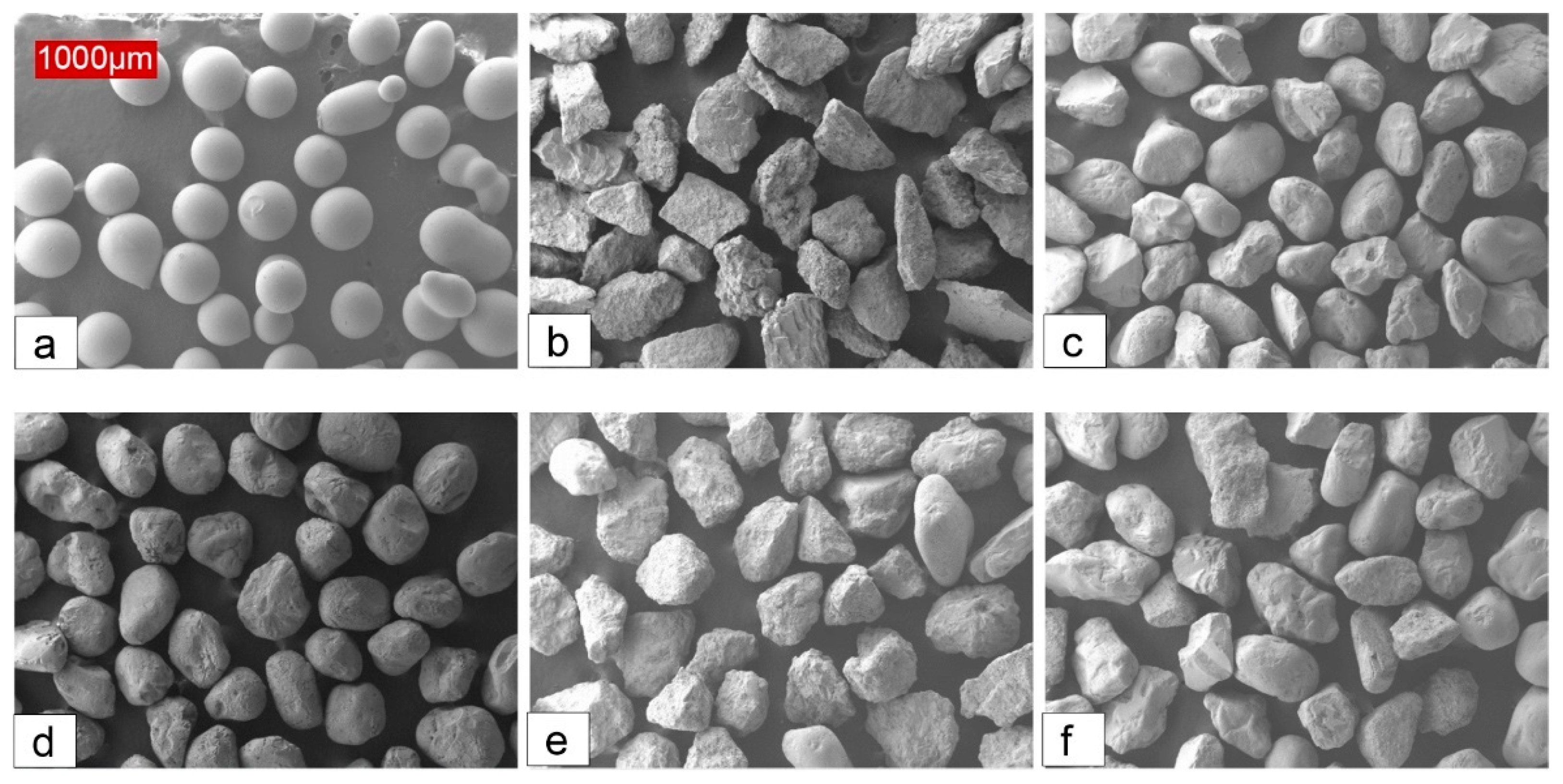
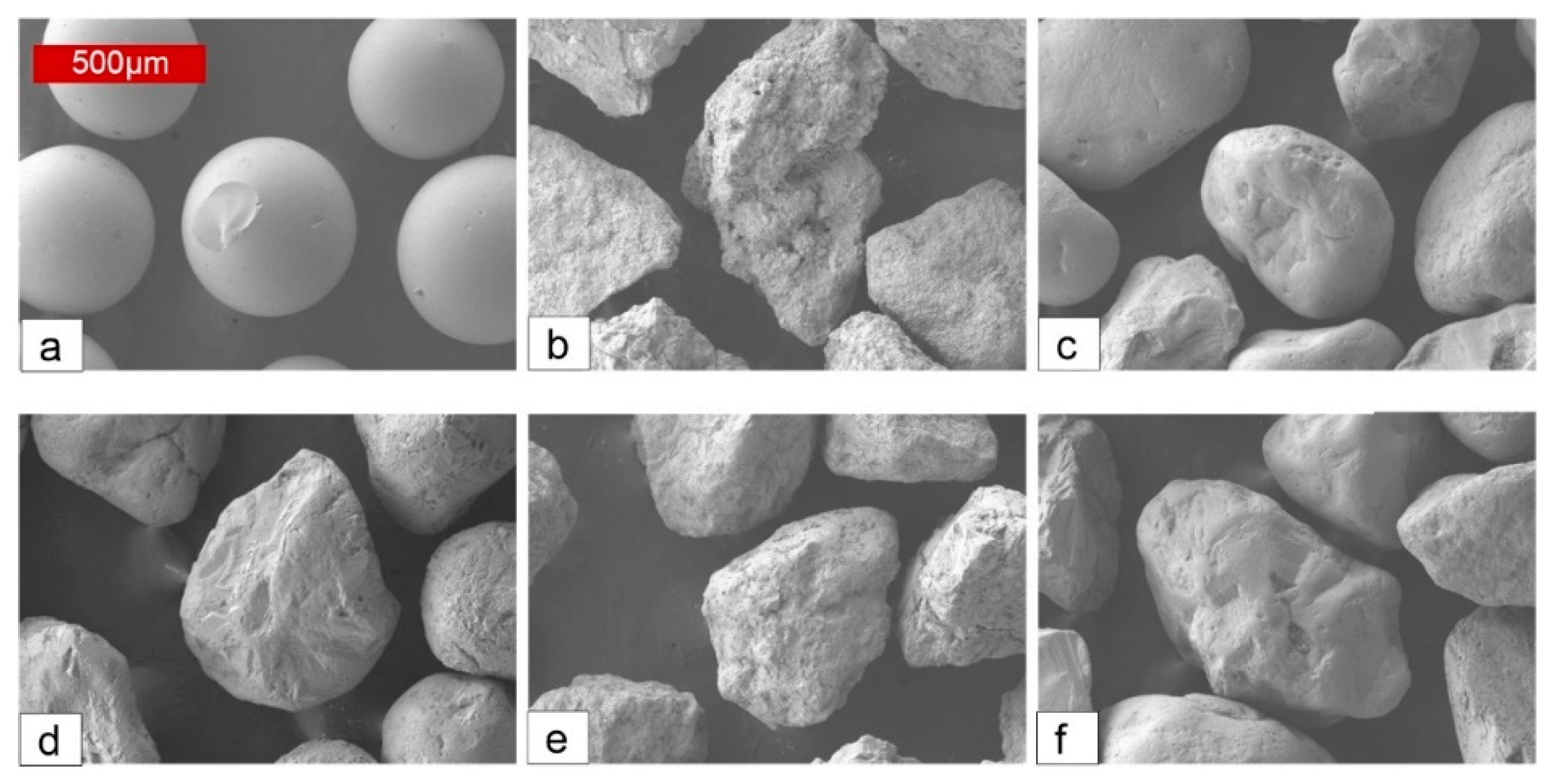
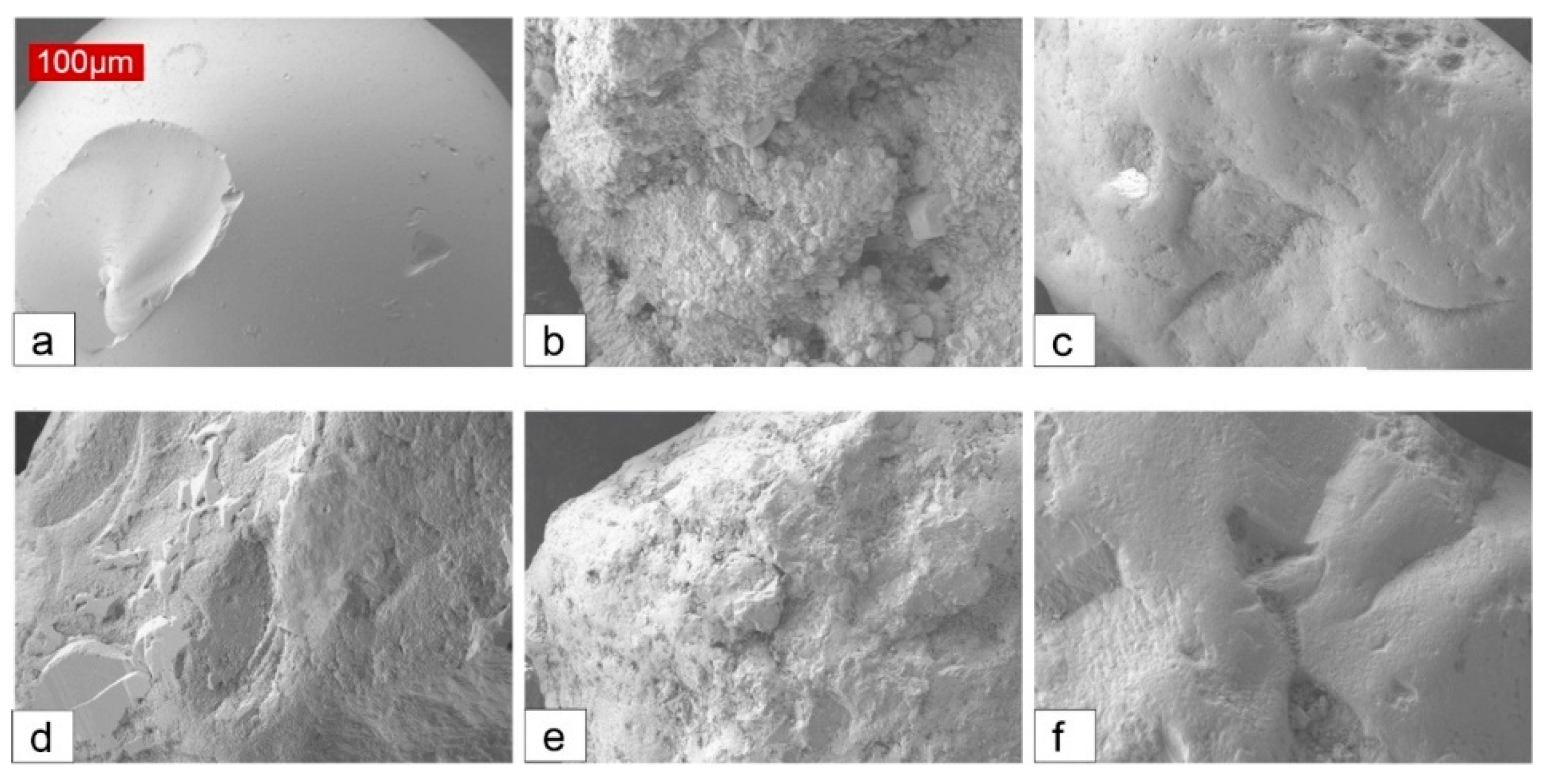
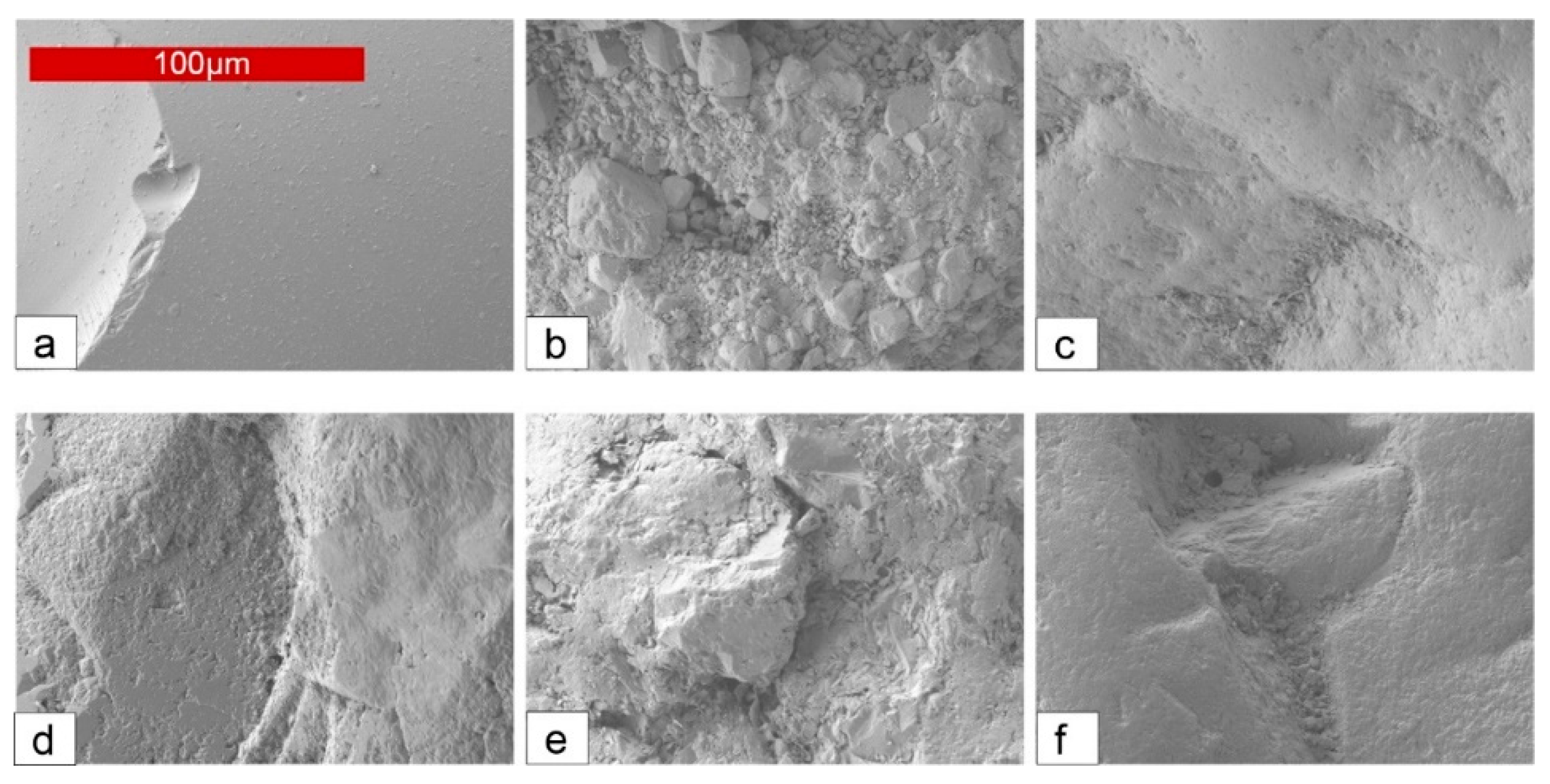
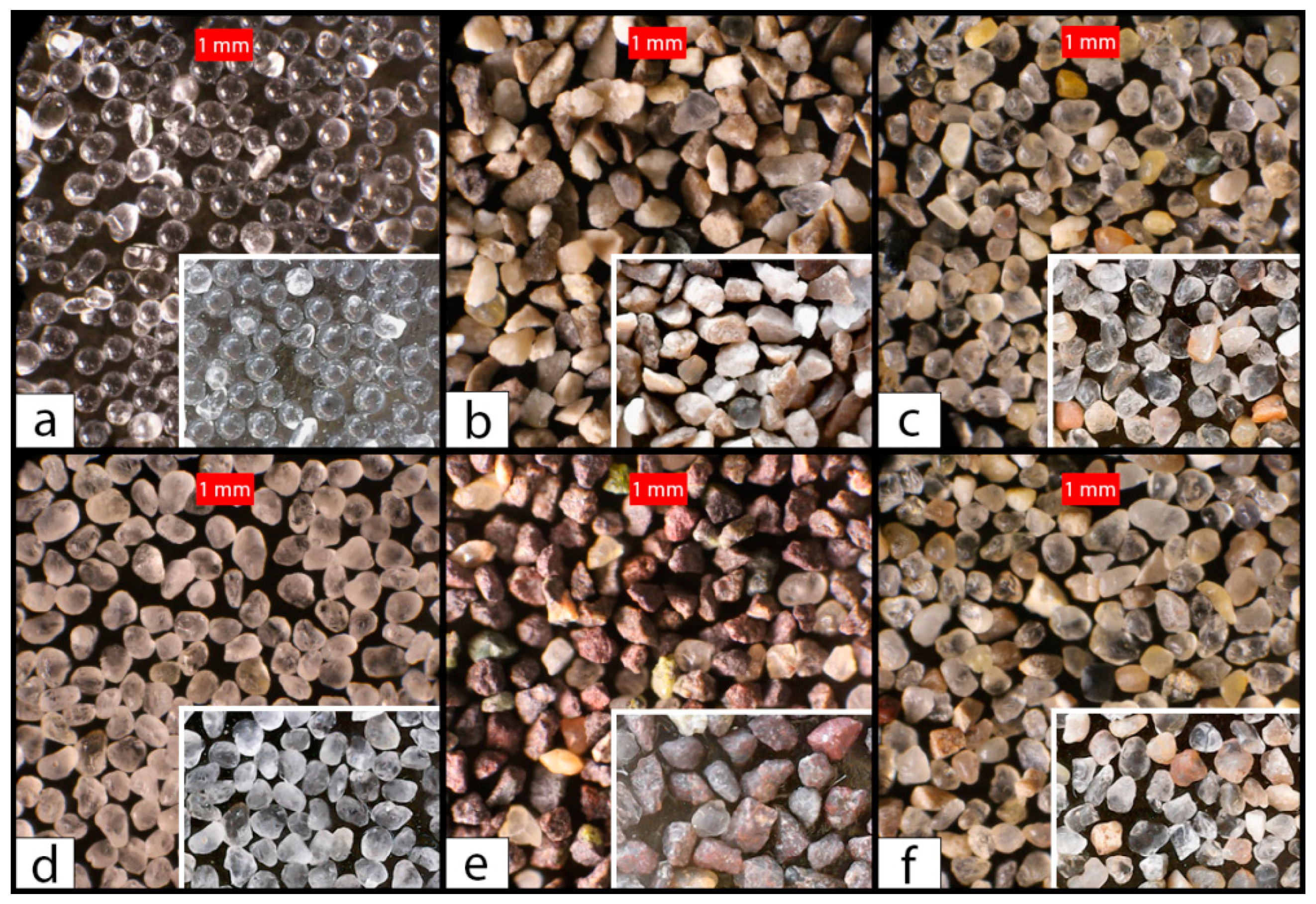
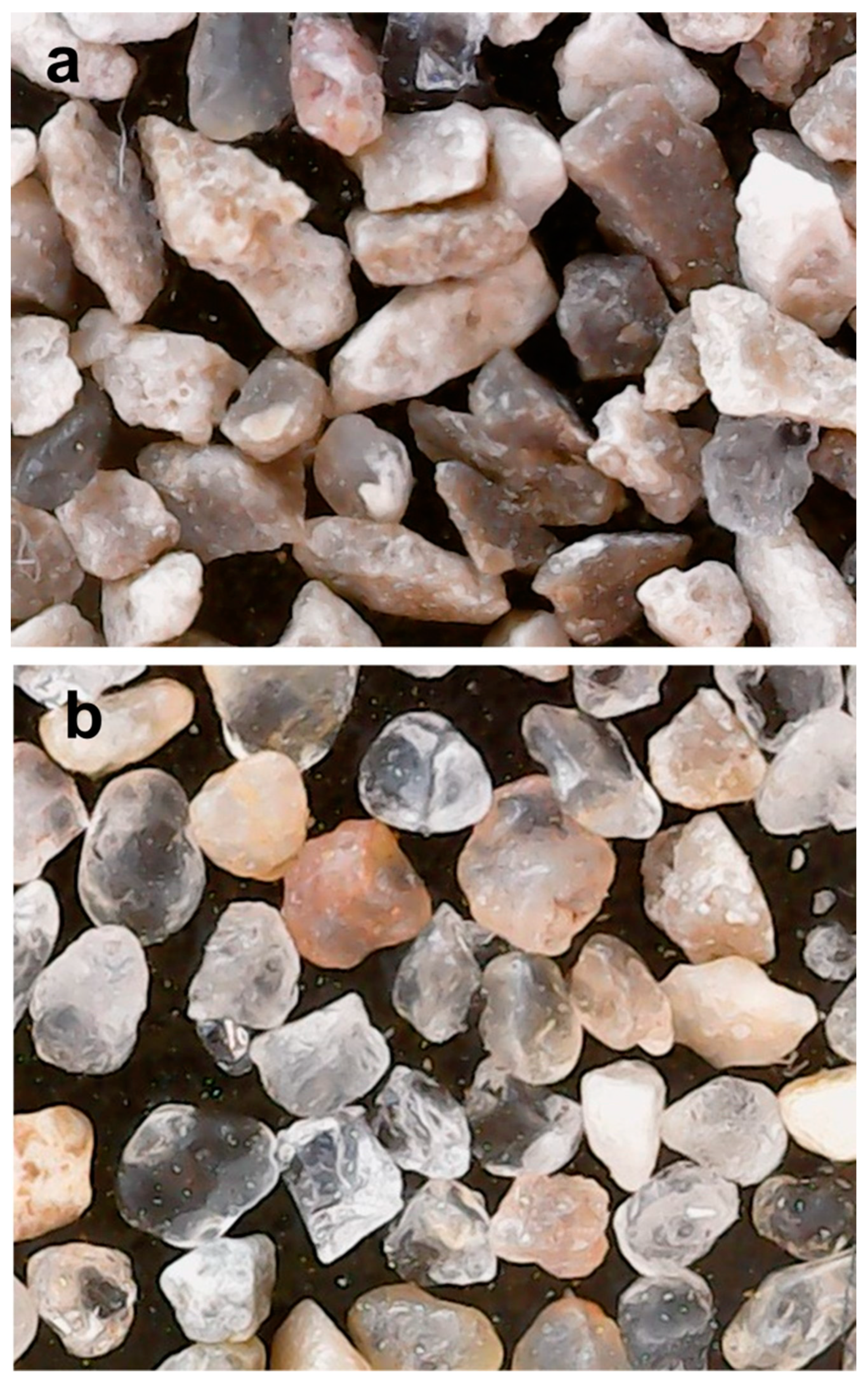
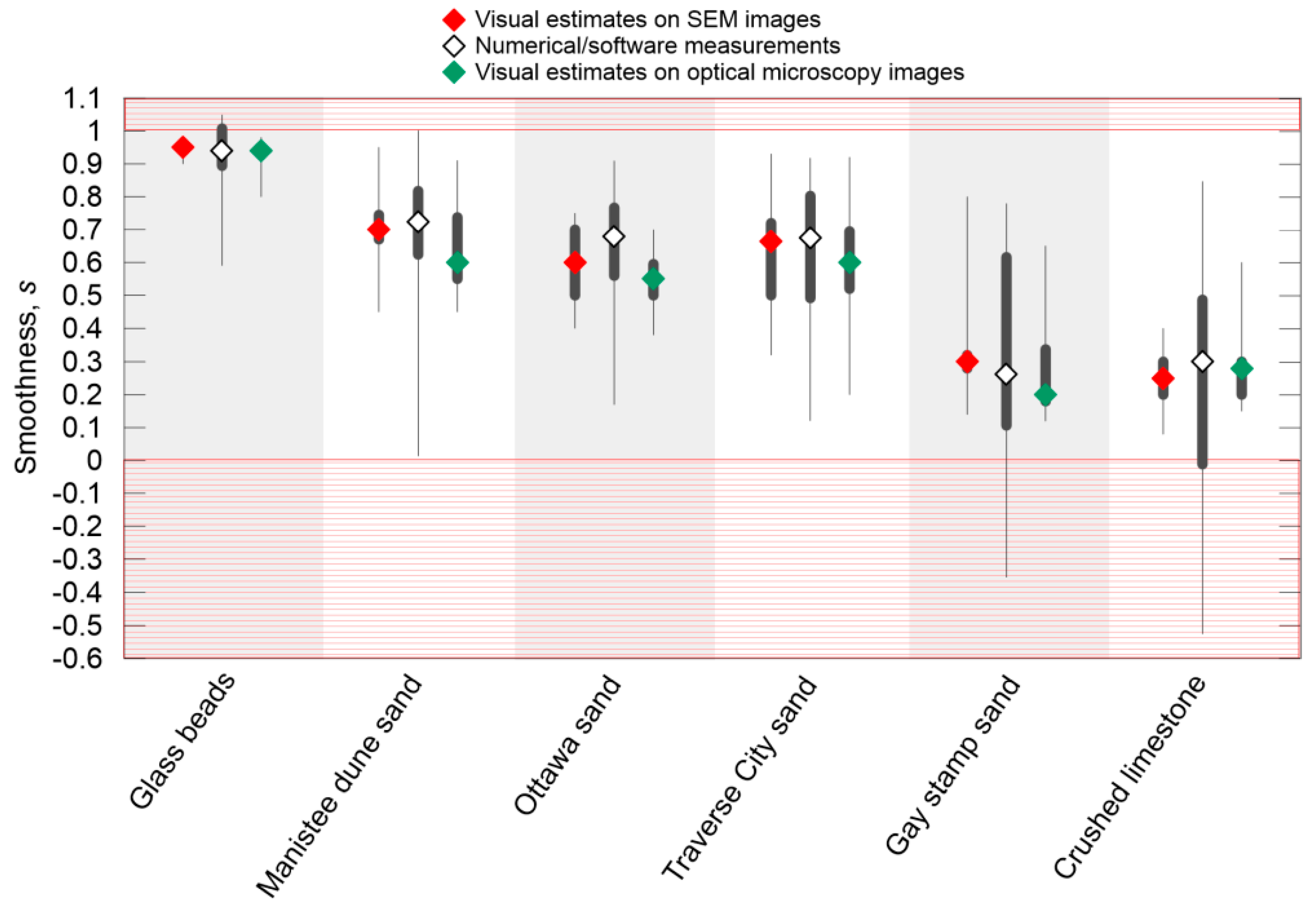
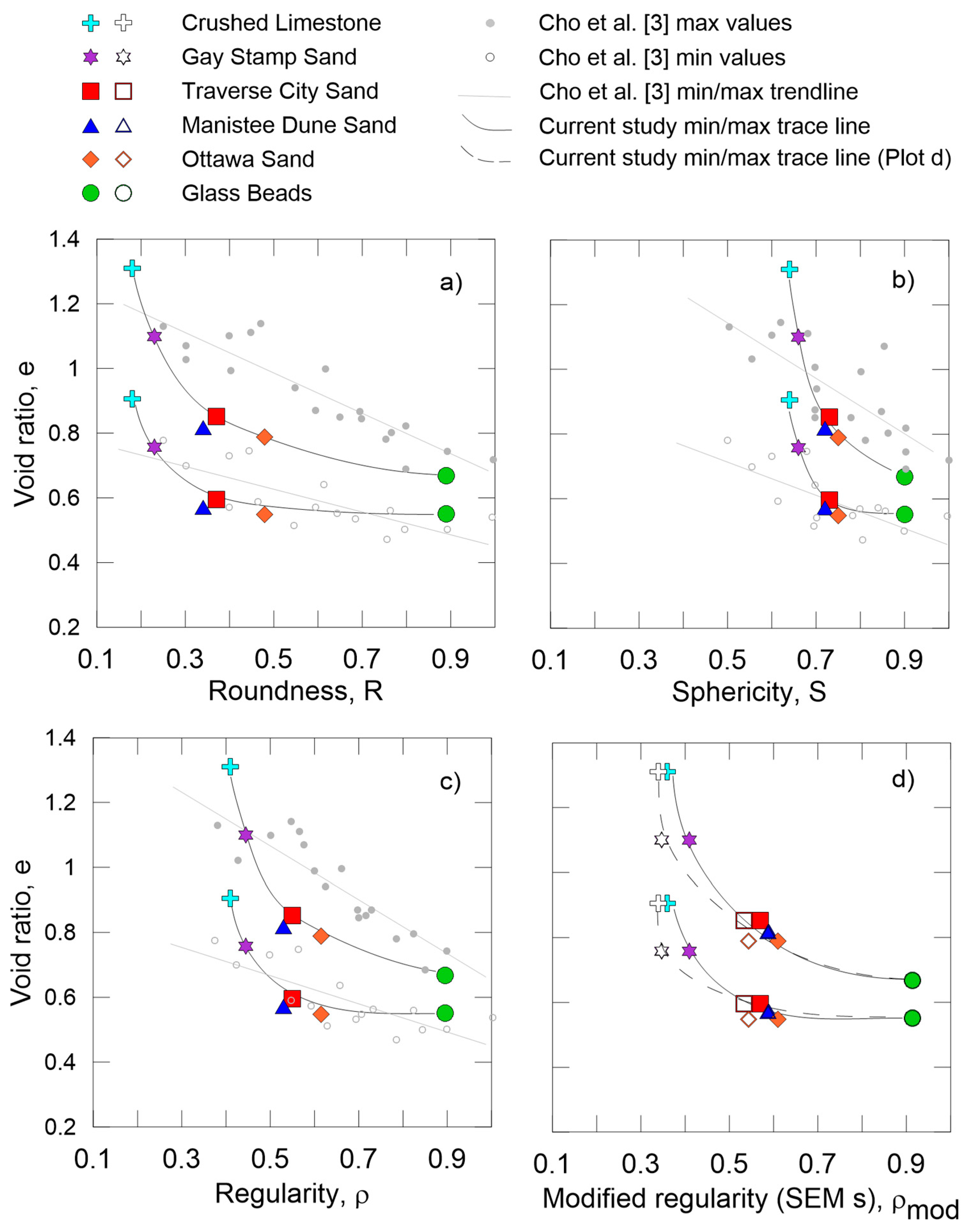
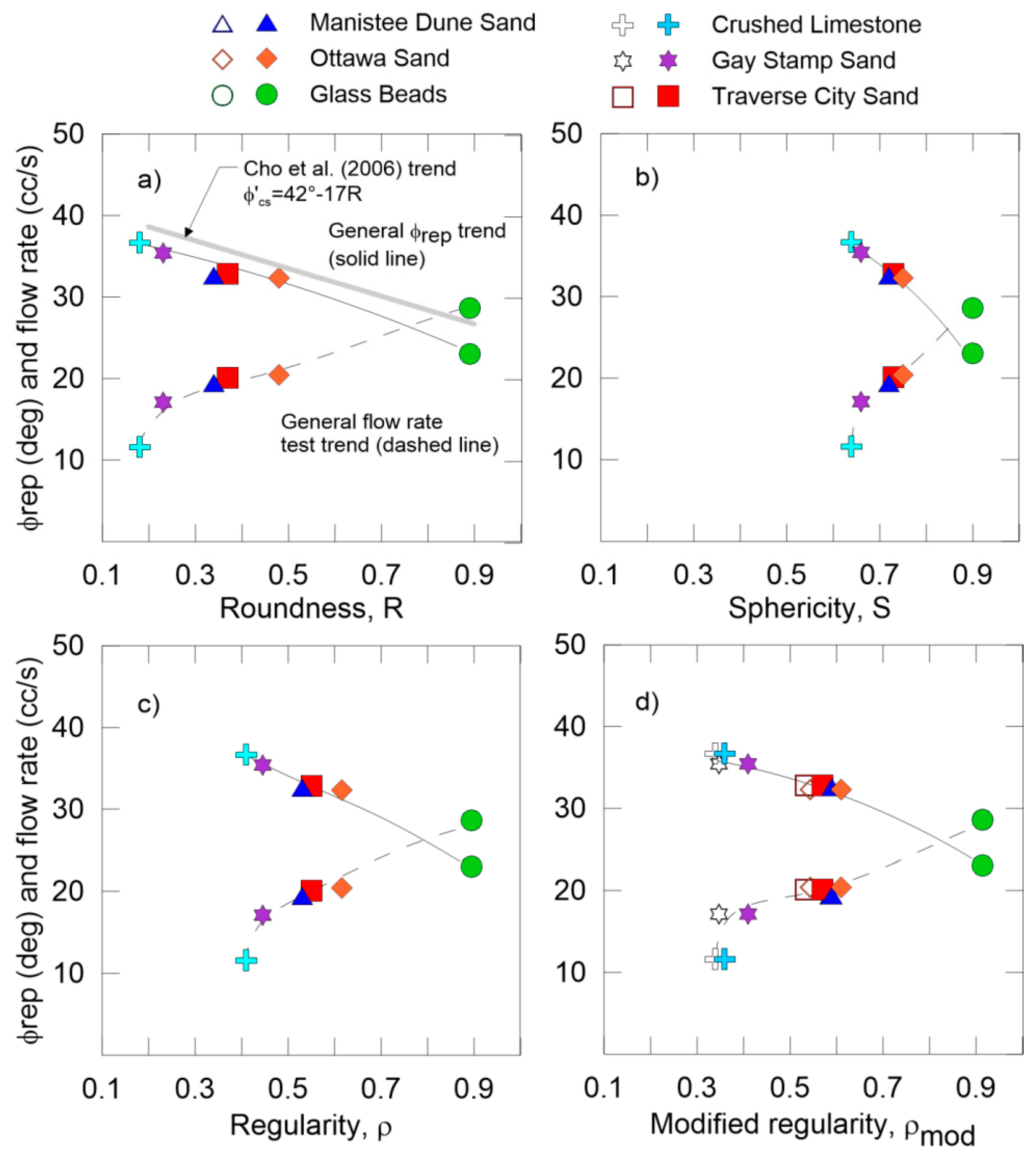
| Classification a (with Symbol) | Average R a |
|---|---|
| Very angular (VA) | 0.15 |
| Angular (A) | 0.20 |
| Subangular (SA) | 0.30 |
| Subrounded (SR) | 0.40 |
| Rounded (Rnd) | 0.60 |
| Well rounded (WR) | 0.85 |
| Classification a (with Symbol) | Average S b |
|---|---|
| Circular (C) | 0.85 |
| Semi-Circular (SC) | 0.60 |
| Semi-Elongated (SE) | 0.40 |
| Elongated (E) | 0.20 |
| Glass Beads | Crushed Limestone | Manistee Dune Sand | ||||||||||
|---|---|---|---|---|---|---|---|---|---|---|---|---|
| Vis-SEM a | Num b | Vis-opt c | Vis-opt2 d | Vis-SEM | Num | Vis-opt | Vis-opt2 | Vis-SEM | Num | Vis-opt | Vis-opt2 | |
| Particles observed | 30 | 30 | -- | 30 | 30 | 30 | -- | 30 | 30 | 30 | -- | 30 |
| Mean | 0.95 | 0.95 | 0.95 | 0.93 | 0.25 | 0.25 | 0.20 | 0.29 | 0.71 | 0.71 | 0.70 | 0.65 |
| Standard deviation | 0.02 | 0.07 | -- | 0.04 | 0.09 | 0.34 | -- | 0.11 | 0.12 | 0.18 | -- | 0.13 |
| Coefficient of variation | 0.02 | 0.07 | -- | 0.04 | 0.36 | 1.36 | -- | 0.38 | 0.17 | 0.25 | -- | 0.20 |
| Minimum | 0.90 | 0.67 | -- | 0.80 | 0.08 | −0.47 | -- | 0.15 | 0.45 | 0.21 | -- | 0.45 |
| Maximum | 0.98 | 1.04 | -- | 0.98 | 0.40 | 0.81 | -- | 0.60 | 0.95 | 0.73 | -- | 0.91 |
| Median | 0.95 | 1.0 | -- | 0.94 | 0.25 | 0.29 | -- | 0.28 | 0.70 | 0.73 | -- | 0.60 |
| Ottawa Sand | Gay Stamp Sand | Traverse City Sand | ||||||||||
| Vis-SEM | Num | Vis-opt | Vis-opt2 | Vis-SEM | Num | Vis-opt | Vis-opt2 | Vis-SEM | Num | Vis-opt | Vis-opt2 | |
| Particles observed | 30 | 30 | -- | 30 | 30 | 30 | -- | 30 | 30 | 30 | -- | 30 |
| Mean | 0.60 | 0.58 | 0.40 | 0.54 | 0.33 | 0.32 | 0.15 | 0.29 | 0.62 | 0.63 | 0.50 | 0.60 |
| Standard deviation | 0.10 | 0.20 | -- | 0.08 | 0.13 | 0.26 | -- | 0.18 | 0.14 | 0.20 | -- | 0.18 |
| Coefficient of variation | 0.16 | 0.34 | -- | 0.15 | 0.39 | 0.81 | -- | 0.62 | 0.23 | 0.32 | -- | 0.30 |
| Minimum | 0.40 | 0.14 | -- | 0.38 | 0.14 | −0.21 | -- | 0.12 | 0.32 | 0.07 | -- | 0.20 |
| Maximum | 0.75 | 0.91 | -- | 0.55 | 0.80 | 0.33 | -- | 0.65 | 0.93 | 0.89 | -- | 0.60 |
| Median | 0.60 | 0.59 | -- | 0.55 | 0.30 | 0.33 | -- | 0.20 | 0.67 | 0.68 | -- | 0.60 |
| Texture Classification for Optical Microscope (with Symbol) | Range of s | Average s |
|---|---|---|
| Noticeably rough surface/highly frosted, with small ridges and/or very dull appearance (LS) | 0.1 to 0.3 | 0.20 |
| Moderately smooth surface/mildly frosted–greasy appearance (MS) | 0.4 to 0.6 | 0.50 |
| Very smooth surface/polished or highly glossy appearance (G) | 0.7 to 1.0 | 0.85 |
| Soil Name | s Estimated Range a | smean a |
|---|---|---|
| Glass beads | 0.90–1.0 | 0.95 |
| Ottawa sand | 0.30–0.50 | 0.40 |
| Manistee dune sand | 0.60–0.80 | 0.70 |
| Traverse City sand | 0.40–0.60 | 0.50 |
| Crushed limestone | 0.10–0.30 | 0.20 |
| Gay stamp sand | 0.10–0.20 | 0.15 |
| Soil Name a | R b | S b | ρ | s c | ρmod-sem c | s e | ρmod-om e | Gs | emax | emin | Ie d | ϕrep deg | q f cc/s |
|---|---|---|---|---|---|---|---|---|---|---|---|---|---|
| Glass beads | 0.89 WR g | 0.90 | 0.90 | 0.95 | 0.91 | 0.95 | 0.91 | 2.47 | 0.668 | 0.551 | 0.117 | 23.0 | 28.6 |
| Crushed limestone | 0.18 A | 0.64 | 0.41 | 0.25 | 0.36 | 0.20 | 0.34 | 2.76 | 1.31 | 0.906 | 0.404 | 36.7 | 11.6 |
| Manistee dune sand | 0.34 SA | 0.72 | 0.53 | 0.71 | 0.59 | 0.70 | 0.59 | 2.68 | 0.818 | 0.571 | 0.247 | 32.6 | 19.4 |
| Ottawa sand | 0.48 SR | 0.75 | 0.62 | 0.60 | 0.61 | 0.40 | 0.54 | 2.66 | 0.789 | 0.548 | 0.241 | 32.3 | 20.4 |
| Gay stamp sand | 0.23 A | 0.66 | 0.45 | 0.33 | 0.41 | 0.15 | 0.35 | 2.90 | 1.10 | 0.758 | 0.342 | 35.4 | 17.1 |
| Traverse City sand | 0.37 SR | 0.73 | 0.55 | 0.62 | 0.57 | 0.50 | 0.53 | 2.69 | 0.852 | 0.595 | 0.257 | 32.8 | 20.1 |
| Approach for Evaluating Smoothness (s) | Advantages | Disadvantages |
|---|---|---|
| Visual evaluation using SEM images; individual particle evaluation |
|
|
| Visual evaluation using optical microscopy images; individual particle evaluation |
|
|
| Visual using optical images; specimens’ s evaluated collectively |
|
|
| Visual using a hand lens; specimens’ s evaluated collectively |
|
|
Disclaimer/Publisher’s Note: The statements, opinions and data contained in all publications are solely those of the individual author(s) and contributor(s) and not of MDPI and/or the editor(s). MDPI and/or the editor(s) disclaim responsibility for any injury to people or property resulting from any ideas, methods, instructions or products referred to in the content. |
© 2023 by the authors. Licensee MDPI, Basel, Switzerland. This article is an open access article distributed under the terms and conditions of the Creative Commons Attribution (CC BY) license (https://creativecommons.org/licenses/by/4.0/).
Share and Cite
Tessari, A.; Muszynski, M. Evaluating Sand Particle Surface Smoothness Using a New Computer-Based Approach to Improve the Characterization of Macroscale Parameters. Geotechnics 2023, 3, 854-873. https://doi.org/10.3390/geotechnics3030046
Tessari A, Muszynski M. Evaluating Sand Particle Surface Smoothness Using a New Computer-Based Approach to Improve the Characterization of Macroscale Parameters. Geotechnics. 2023; 3(3):854-873. https://doi.org/10.3390/geotechnics3030046
Chicago/Turabian StyleTessari, Anthony, and Mark Muszynski. 2023. "Evaluating Sand Particle Surface Smoothness Using a New Computer-Based Approach to Improve the Characterization of Macroscale Parameters" Geotechnics 3, no. 3: 854-873. https://doi.org/10.3390/geotechnics3030046
APA StyleTessari, A., & Muszynski, M. (2023). Evaluating Sand Particle Surface Smoothness Using a New Computer-Based Approach to Improve the Characterization of Macroscale Parameters. Geotechnics, 3(3), 854-873. https://doi.org/10.3390/geotechnics3030046






